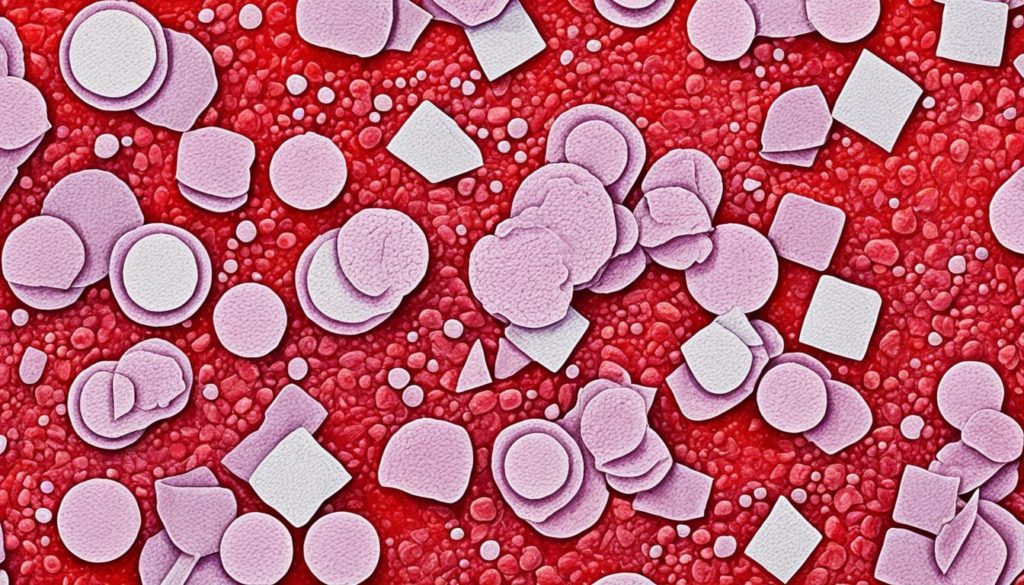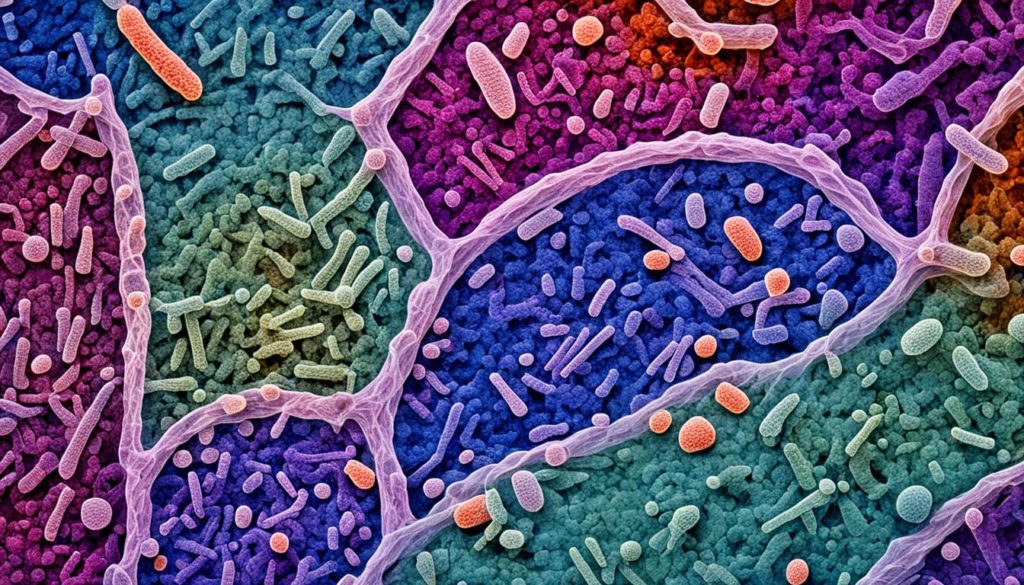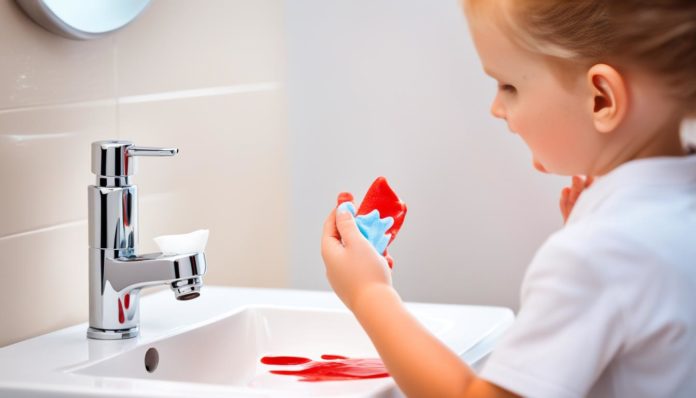Did you know impetigo affects a lot of kids? In fact, it’s behind up to 10% of skin problems kids have in the U.S. Although it spreads fast, you can treat it easily if you know how. It’s important to learn about impetigo’s causes and treatments to stop its spread and effects.
This guide will give you a full look at impetigo, from what causes it to how it’s treated. It’s useful for parents and health professionals alike. You’ll learn how to spot, treat, and get over impetigo.
Key Takeaways
- Impetigo is a highly contagious bacterial skin infection prevalent among children.
- Understanding the causes of impetigo can aid in effective prevention strategies.
- Early diagnosis is crucial for implementing timely and effective impetigo treatment.
- Good hygiene practices are essential in preventing the spread of impetigo.
- Various home remedies and over-the-counter solutions can complement medical treatments.
What is Impetigo?
Impetigo is a common skin infection that mainly affects children but can also occur in adults. It usually appears on the skin as lesions and blisters. These can be uncomfortable and look bad. Knowing about impetigo is important to recognize and manage it.

Definition and Overview
The definition of impetigo includes a bacterial skin infection. It often comes from Staphylococcus aureus or Streptococcus pyogenes bacteria. It starts with red sores or blisters that pop open and form crusty, yellowish scabs. This infection is most common in kids between 2-5 years old. However, it can affect people of any age, especially in warm and humid places.
Types of Impetigo
There are three main types of impetigo, each different:
- Nonbullous (crusted) impetigo: This type is the most common. It features small blisters or sores that break open and become crusted.
- Bullous impetigo: This mainly affects babies and young children with big blisters. The blisters may turn cloudy and don’t crust when they burst.
- Ecthyma: The most severe form, ecthyma goes deeper into the skin causing painful ulcers under the crusts. It usually happens if the other two types are not treated.
Causes of Impetigo
Impetigo mainly comes from a bacterial infection. Two kinds of bacteria, Staphylococcus aureus and Streptococcus pyogenes, are usually to blame. These germs love warm, damp places. They can get into the skin if it’s cut, scraped, or bitten by insects.

Bacterial Infection
A big reason for impetigo is an *infection* caused by bacteria. *Staphylococcus aureus*, or staph, is very common. It can lead to skin problems. *Streptococcus pyogenes*, or strep, also causes these skin issues. These bacteria easily spread, making many kids get impetigo.
Risk Factors
Some things can make getting impetigo more likely. Kids, especially from 2 to 5 years old, are at a bigger risk. They often get cuts and scrapes. They also stay close to each other in schools or daycares. People with weak immune systems or those in crowded living situations are more at risk too.
Places that are hot and humid also help this *bacterial infection* spread. Knowing what leads to impetigo helps in stopping it and taking care of it.
| Factor | Impact |
|---|---|
| Age | Children are more susceptible. |
| Compromised Skin | Cuts and scrapes facilitate bacterial entry. |
| Immune System | Weakened defenses increase risk. |
| Climate | Hot, humid environments promote bacterial growth. |
Symptoms of Impetigo
It’s very important to spot impetigo symptoms early for good treatment. Knowing how impetigo signs develop helps determine the next steps.
Common Signs
Impetigo starts with red sores or blisters around the nose, mouth, hands, and feet. These sores then break open, releasing a clear or yellowish fluid, and become crusty.
Other common impetigo signs are:
- Itchy, red sores that spread when scratched
- Blisters filled with fluid in clusters
- Lesions that grow over several days
- Discomfort or pain in affected spots
When to Seek Medical Attention
Although you might treat impetigo at home, sometimes you need a doctor. Visit a healthcare provider if you see these impetigo symptoms:
- Sores that don’t heal in a week
- The infection spreading fast
- Fever or swollen lymph nodes
- Signs of a bad secondary infection, like increased redness or swelling
Getting help quickly helps avoid complications and stops the spread to others.
Impetigo Diagnosis
Getting the right diagnosis for impetigo is key for treating it well. We’ll look at how doctors confirm if someone has impetigo. They check symptoms closely and may use lab tests too.
Clinical Examination
Doctors start with a careful check-up to spot impetigo. They look for signs like crusty, honey-colored sores and blisters. They also consider the patient’s health history and any contact with impetigo. During the check-up, doctors note:
- How the sores look
- Where the sores are and how they’re spreading
- If there’s itching or discomfort
- Any other skin problems
Laboratory Tests
Sometimes, a physical exam isn’t enough to be sure it’s impetigo. That’s when lab tests come in. These tests pinpoint the exact bacteria causing the issue. This ensures the treatment is right on target. The main tests include:
- Swab tests from the sores
- Blood checks for other infections
- Looking at skin scrapes under a microscope
This table sums up how doctors diagnose impetigo:
| Diagnostic Method | Description | Purpose |
|---|---|---|
| Clinical Examination | Physical assessment, history review | Initial diagnosis, symptom identification |
| Culture Test | Swabbing and culturing bacteria | Bacterial identification and sensitivity |
| Microscopic Examination | Analysis of skin cells | Confirm diagnosis, rule out similar conditions |
Impetigo Treatment Options
Healthcare providers look at the severity and type of impetigo before choosing treatment. They often use both topical and oral antibiotics to fight the infection.
Topical antibiotics are the starting point for treatment. Applied to the skin, they kill the bacteria causing impetigo. Effective topical antibiotics include:
- Mupirocin
- Retapamulin
If the impetigo is severe or widespread, doctors may prescribe oral antibiotics. Taken by mouth, these help fight the infection from inside. For impetigo, common choices are:
- Cephalexin
- Dicloxacillin
Choosing between topical or oral antibiotics depends on many factors. These include the patient’s age, if they have allergies, and how bad the infection is.
“Treatment efficacy relies not just on the type of antibiotic, but also timely administration and adherence to the prescribed regimen,” notes medical expert Dr. Lisa M. Galer.
Let’s compare topical and oral antibiotics in terms of how they’re used, their effectiveness, and when they’re typically prescribed:
| Criteria | Topical Antibiotics | Oral Antibiotics |
|---|---|---|
| Administration | Applied directly to the skin | Ingested by mouth |
| Effectiveness | Effective for localized infections | Effective for more widespread infections |
| Typical Usage | Mild to moderate cases | Moderate to severe cases |
Knowing about impetigo treatment options helps patients and caregivers make informed choices. This ensures the infection is treated quickly and effectively.
Home Remedies for Impetigo
Managing impetigo at home is smart and saves money. It’s always best to see a doctor, but home remedies can help too. This part talks about natural and store-bought ways to treat impetigo.
Natural Treatments
Natural treatments for impetigo have helped many people. They use what nature offers to speed up healing. Let’s look at a few:
- Tea Tree Oil: With its antibacterial power, tea tree oil helps fight the infection. Mix a few drops with a carrier oil before applying it to the skin.
- Honey: Put raw honey on the skin. It kills germs, stops itching, and helps skin heal.
- Essential Oils: Lavender and chamomile oils are good, too. They kill germs. Use them like tea tree oil.
Over-the-Counter Solutions
There are also non-prescription ways to deal with impetigo. They help with symptoms and make healing faster. Some options are:
- Antibiotic Creams: Use creams like Neosporin on sores. They kill bacteria and make sores heal quicker.
- Antiseptic Wipes: Wipes with gentle antiseptics clean the skin and stop bacteria from spreading.
- Hydrocortisone Cream: This eases itching and swelling. It makes dealing with impetigo easier.
Home remedies and non-prescription methods can really help with impetigo. But, it’s important to talk to a healthcare provider for a full treatment plan, especially if it’s a bad case.
Prevention Techniques
Stopping impetigo before it starts is key to keeping healthy. It’s important to stay clean and keep away from those who are sick.
Good Hygiene Practices
Staying clean is crucial to avoid impetigo. Wash your hands well with soap and water. This is especially important after you touch your skin or any wounds. Let’s look at some important habits:
- Handwashing: Make sure to wash your hands often, for at least 20 seconds each time.
- Wound care: Keep cuts and bites clean and covered up.
- Personal items: Always use your own towels, razors, and clothes. Don’t share them.
Avoiding Contact
Staying away from sick people and their things is vital. If someone you live with gets sick, here’s what to do:
- Try not to touch the sick person’s skin or sores.
- Don’t use the same bedding, towels, or clothes as them.
- Disinfect surfaces: Clean places that everyone touches often.
Is Impetigo Contagious?
Impetigo is a skin infection that spreads easily. Knowing how it spreads and how to stop it is key. This helps control it effectively.
Transmission Methods
Direct skin contact with infected lesions mainly spreads impetigo. Sharing items like towels can also spread it. It’s especially easy to catch in tight spaces, like at home or school.
Preventing Spread
To stop the spread of impetigo, do the following:
- Regular hand washing with soap and water
- Avoiding the sharing of personal items
- Covering any open sores or lesions
- Cleaning and disinfecting surfaces and objects frequently
By taking these steps, you and your family can greatly lower the risk of getting or spreading impetigo.
Here is a brief overview of how impetigo spreads and how to prevent it:
| Transmission Methods | Prevention Strategies |
|---|---|
| Direct skin-to-skin contact | Frequent hand washing |
| Sharing personal items | Avoid item sharing |
| Contaminated surfaces | Regular cleaning and disinfection |
| Close environments | Covering sores and lesions |
Impetigo in Children
Impetigo is a common skin infection in kids, spreading quickly. It starts as reddish sores, then forms honey-colored crusts. The areas around the nose, mouth, hands, and feet are often affected. Kids get it easily due to lots of touching and sharing things like toys.
Impetigo does more than hurt the skin. It can mess with daily life, making kids miss school. Families must also change how they clean things at home. To stop its spread, clean hands often and don’t share personal stuff. The Mayo Clinic says antibiotics are key for getting better fast. Learn more about the symptoms to protect your kids.
Parents should watch for impetigo signs and act fast. Quick treatment helps avoid serious problems like cellulitis, kidney issues, and scars. Knowing about impetigo’s risks helps parents and caregivers keep their children safe and healthy.
Impetigo in Adults
Impetigo in adults brings unique challenges. These include lifestyle, health, and where you work. Knowing these is key for better management and prevention.
Impetigo in adults mainly comes from bacterial infections, like Staphylococcus aureus or Group A streptococcus. These bacteria get in through cuts or issues like eczema or bug bites. The infection starts fast, showing up as rashes and blisters.
In places like work or the gym, adults need to be extra careful. Impetigo spreads easily through touching and sharing things. Good hygiene can greatly lower the risk.
Getting treatment often means seeing a doctor. Antibiotics can really help with symptoms. To learn more about impetigo in adults, check out Cleveland Clinic Impetigo Information.
- Maintain personal hygiene
- Avoid sharing personal items
- Seek medical attention for lasting symptoms
- Complete your antibiotics treatment
Some people worry about problems like kidney disease or scars. But with the right care, these are rare.
| Aspect | Details |
|---|---|
| Causes | Bacterial infections (Staphylococcus aureus and Group A streptococcus) |
| Symptoms | Rashes, blisters, rapid onset |
| Transmission | Highly contagious through skin contact and shared items |
| Treatment | Antibiotics, hygiene practices |
| Complications | Rare, can include kidney disease or scarring |
Following advice and getting treatment quickly makes handling impetigo easier and more effective.
Living with Impetigo
Living with impetigo can be tough. Yet, with the right knowledge and support, you can manage it better. This section shares key impetigo care tips and vital impetigo support resources. These will help you handle the condition more smoothly.
Daily Care Tips
Good daily care is key for those with impetigo. Here, you’ll find some impetigo care tips. These will help you manage and recover from the condition.
- Maintain Cleanliness: Clean the affected area with gentle soap and water regularly. Then, dry it with a clean towel to stop bacteria from spreading.
- Use Antibiotic Ointments: Use the antibiotic creams your doctor gives you as they tell you. This helps fight the infection.
- Avoid Scratching: Don’t scratch the sores. Scratching can lead to more infections and scars.
- Keep Nails Short: Cutting your nails short helps prevent damage from accidental scratching.
- Separate Personal Items: Use your own towels, washcloths, and bedding. This stops impetigo from spreading to others in your home.
Support and Resources
Getting the right support and resources is vital for those with impetigo. Here’s how:
- Healthcare Providers: See your dermatologist or doctor often. They can give you advice that fits your situation.
- Support Groups: Being part of support groups lets you meet others facing similar issues. It’s a great way to get emotional support and advice.
- Educational Resources: Use reliable sources like the Mayo Clinic or the American Academy of Dermatology. They have the latest info on treatments and care tips.
- Online Communities: Join forums and social media groups about skin health. They offer support and tips from people who know what you’re going through.
Using these resources can make living with impetigo easier. Remember, getting regular care and support helps you manage impetigo well.
Conclusion
We’ve learned about impetigo’s causes, symptoms, and treatments. Spotting it early and getting quick treatment is key. With the right care, people can recover fast.
Keeping clean and staying away from those who are sick helps avoid impetigo. Although it spreads easily, there are many treatments available. These range from simple creams to antibiotics.
Knowing about impetigo helps us lessen its effect, especially in kids and those with weak immune systems. Being aware and well-informed helps stop its spread. This guide highlights how crucial it is to take care of ourselves, get treated on time, and prevent it whenever possible.
FAQ
What causes impetigo?
Impetigo comes from a bacterial infection. This is mostly due to Staphylococcus aureus or Streptococcus pyogenes bacteria. These germs get into the skin if there’s a small cut, an insect bite, or a scratch.
What are the common symptoms of impetigo?
The main signs of impetigo are red sores or blisters. These quickly pop open, ooze for a few days, and then turn into a yellow-brown crust. The sores can be itchy and may spread if not taken care of.
How is impetigo diagnosed?
Doctors can tell you have impetigo by looking at your skin. To be sure, they may also test a sample from the sore. This confirms the bacteria causing the infection.
What are the treatment options for impetigo?
You can treat impetigo with creams like mupirocin or fusidic acid. For serious cases, you might need oral antibiotics. Remember to finish all the medicine prescribed.
Can impetigo be treated with home remedies?
Yes, but medical treatments work best. Things like tea tree oil and some creams can ease symptoms. Always talk to a doctor before trying home remedies.
How can I prevent spreading impetigo to others?
Keep your hands clean, trim your nails, and don’t share personal items. Also, stay away from others until your infection heals. This stops the spread.
Is impetigo contagious?
Very much so. It spreads by touching someone with impetigo or their things. Keeping clean and getting treatment is key to stopping it.
How does impetigo affect children differently than adults?
Kids get impetigo more often due to close contact with others and their immune systems being less mature. It can mean missing school or daycare.
What risk factors increase the likelihood of developing impetigo?
Being young, having skin injuries, doing contact sports, crowded places, and poor skin health raise the risk. Good skin care can cut down on these risks.
When should I seek medical attention for impetigo?
Go to a doctor if sores get worse, spread fast, or if there’s a fever. Also, if there’s pain, swelling, or redness, get help right away.
What are the long-term effects of impetigo?
If treated, impetigo usually leaves no lasting harm. But, neglecting it can lead to serious issues like cellulitis, kidney problems, or scars.
What lifestyle changes can help manage and prevent impetigo?
Staying clean, treating cuts right away, not sharing items, and keeping skin moisturized can prevent impetigo. These steps keep your skin healthy and free from infection.


